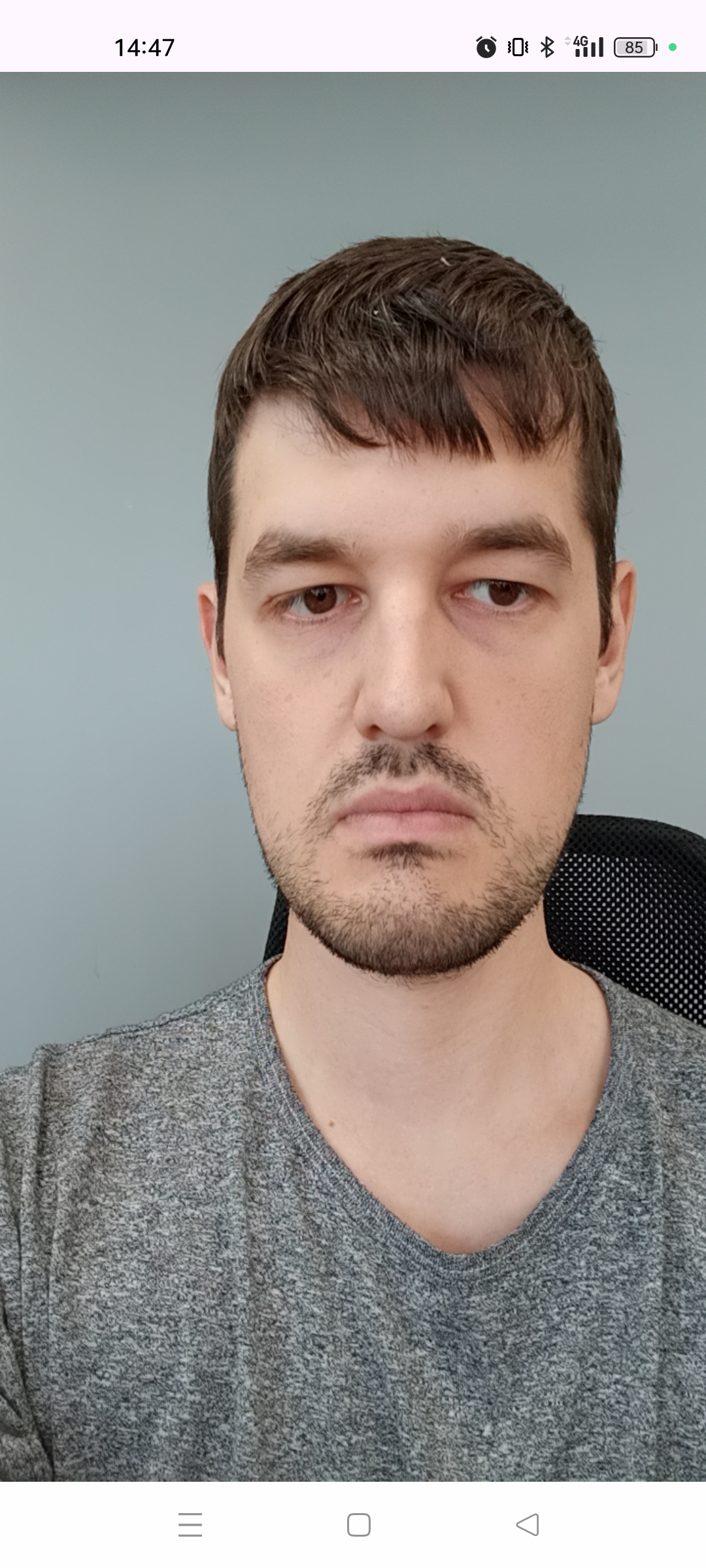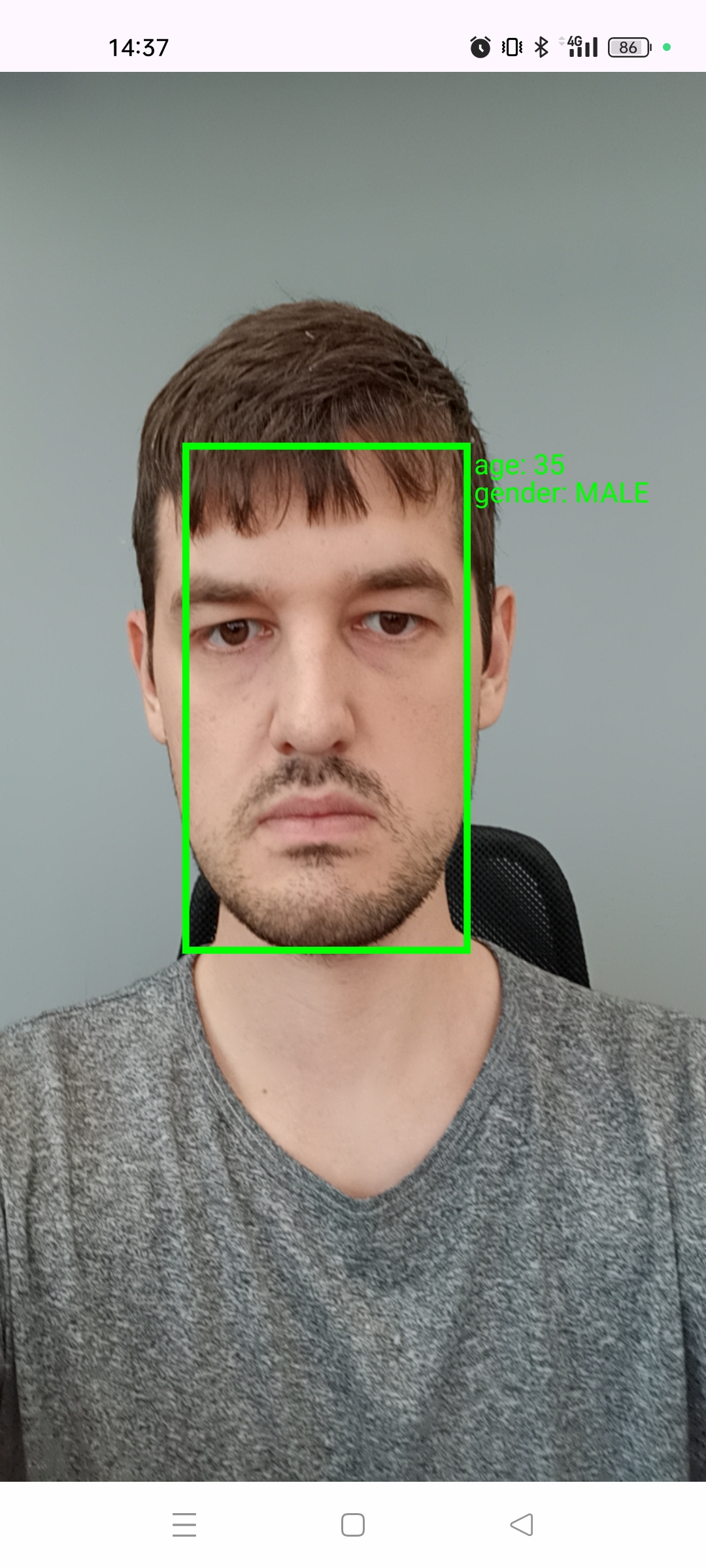Face detection from phone camera
In this tutorial, you'll learn how to use the Processing Block API objects from the Face SDK to detect faces and estimate their age and gender.
Detected faces will be highlighted with a green bounding box (bbox). Information about the person's age and gender will appear on the left.
To work, you will need a phone with Android operating system version 7.0 or higher, as well as Android Studio tools.
The project source code is available in Face SDK examples/tutorials/kotlin/KotlinTutorial
Project preparation
- Launch AndroidStudio and create a new project File > New > Project. Select the Empty Views Activity template and click
next. - Specify the name and location of your project, install the minimum version of Android sdk 24 or higher and click
finish.
Working with the camera
Obtaining permissions to use the camera
Add to
AndroidManifest.xml.<manifest xmlns:android="http://schemas.android.com/apk/res/android"
xmlns:tools="http://schemas.android.com/tools">
// ................................................
<uses-feature
android:name="android.hardware.camera"
android:required="false" />
<uses-permission android:name="android.permission.CAMERA"/>In the
MainActivity.ktfile in theMainActivityclass, add thegetPermisionmethod and callonCreatein theonCreatemethod.private fun getPermission(){
if (ContextCompat.checkSelfPermission(this, android.Manifest.permission.CAMERA) !=
PackageManager.PERMISSION_GRANTED){
requestPermissions(arrayOf(android.Manifest.permission.CAMERA), 0)
}
}Override the
onRequestPermissionsResultmethod and call thegetPermissionmethod in it.override fun onRequestPermissionsResult(
requestCode: Int,
permissions: Array<out String>,
grantResults: IntArray
) {
super.onRequestPermissionsResult(requestCode, permissions, grantResults)
getPermission()
}
Receiving frames from the camera
In
/app/src/main/res/layout/activity_main.xmlremoveTextViewand addTextureViewto display camera image.<TextureView
android:layout_height="match_parent"
android:layout_width="match_parent"
android:id="@+id/textureView" />Add the variables
cameraManager,cameraDevice,cameraCaptureSession,handlerThread,handler,textureView,previewSizeto theMainActivityclass.class MainActivity : AppCompatActivity() {
//........................................
private lateinit var cameraManager: CameraManager
lateinit var cameraDevice: CameraDevice
lateinit var cameraCaptureSession: CameraCaptureSession
private lateinit var handlerThread: HandlerThread
lateinit var handler: Handler
lateinit var textureView: TextureView
val previewSize = Size(1280, 720)Add
getFrontalCameraIdandopenCameramethods.private fun getFrontalCameraId(): String {
return cameraManager.cameraIdList.first {
cameraManager
.getCameraCharacteristics(it)
.get(CameraCharacteristics.LENS_FACING) == CameraCharacteristics.LENS_FACING_FRONT
}
}
@SuppressLint("MissingPermission")
fun openCamera(){
cameraManager.openCamera(getFrontalCameraId(), object : CameraDevice.StateCallback(){
override fun onOpened(p0: CameraDevice) {
cameraDevice = p0
val surfaceTexture = textureView.surfaceTexture
surfaceTexture?.setDefaultBufferSize(previewSize.width, previewSize.height)
val capReq = cameraDevice.createCaptureRequest(CameraDevice.TEMPLATE_PREVIEW)
val surface = Surface(surfaceTexture)
capReq.addTarget(surface)
cameraDevice.createCaptureSession(listOf(surface), object: CameraCaptureSession.StateCallback(){
override fun onConfigured(p0: CameraCaptureSession) {
cameraCaptureSession = p0
cameraCaptureSession.setRepeatingRequest(capReq.build(), null, null)
}
override fun onConfigureFailed(p0: CameraCaptureSession) {
}
}, handler)
}
override fun onDisconnected(p0: CameraDevice) {}
override fun onError(p0: CameraDevice, p1: Int) {}
}, handler)
}Initialize all variables after calling
getPermision.textureView = findViewById(R.id.textureView)
cameraManager = getSystemService(Context.CAMERA_SERVICE) as CameraManager
handlerThread = HandlerThread("videoThread")
handlerThread.start()
handler = Handler(handlerThread.looper)
textureView.surfaceTextureListener = object : TextureView.SurfaceTextureListener{
override fun onSurfaceTextureAvailable(p0: SurfaceTexture, p1: Int, p2: Int) { openCamera() }
override fun onSurfaceTextureUpdated(p0: SurfaceTexture) { }
override fun onSurfaceTextureDestroyed(p0: SurfaceTexture): Boolean { return false }
override fun onSurfaceTextureSizeChanged(p0: SurfaceTexture, p1: Int, p2: Int) { }
}Add portrait orientation for
MainActivity. To do this, go toAndroidManifest.xmland in <activity ...> write android:screenOrientation="portrait".<activity
android:name=".MainActivity"
android:exported="true"
android:screenOrientation="portrait">

Connecting Face SDK to the project
Setting up build.gradle.kts
Add a copy of the Face SDK libraries to your project. To do this, enter
androidin the field.sourceSets {
this.getByName("main"){
jniLibs {
srcDir("/path/to/face_sdk/lib")
}
}
}Add functions to copy Face SDK configuration files and models into your project.
task("computeAssetsHash") {
doLast {
mkdir("$projectDir/src/main/assets/")
File("$projectDir/src/main/assets/", "assets-hash.txt").writeText(
"Buildtime ${LocalDateTime.now().format(DateTimeFormatter.ofPattern("YYYY:MM:dd:HH:mm:ss"))}"
)
}
}
task<Copy>("copyFiles") {
description = "Copy files"
from("/path/to/face_sdk/") {
include(
"conf/**",
"share/processing_block/age_estimator/light/2.enc",
"share/processing_block/gender_estimator/light/2.enc",
"share/processing_block/face_fitter/fda/1.enc",
"share/processing_block/face_detector/blf_front/1.enc",
"license/**"
)
}
into("$projectDir/src/main/assets/")
}Import
dependsOnand call thecomputeAssetsHashandcopyFilesfunctions.import com.android.build.gradle.internal.tasks.factory.dependsOn
//........................................................ ..............
project.tasks.preBuild.dependsOn("computeAssetsHash")
project.tasks.preBuild.dependsOn("copyFiles")In dependencies, include facerec.jar.
implementation(files("/path/to/face_sdk/lib/facerec.jar"))
Getting Face SDK assets inside the application
In the application, assets are stored in compressed form. To obtain Face SDK assets, we will add a new entry point to the application, in which we will unpack them to another location.
Create a new file
UnpackAssetsActivity.ktsand classUnpackAssetsActivity.// activity to upack all assets
class UnpackAssetsActivity : Activity() {
public override fun onCreate(savedInstanceState: Bundle?) {
super.onCreate(savedInstanceState)
try {
// read first line from assets-hash.txt
val newHash =
BufferedReader(InputStreamReader(assets.open("assets-hash.txt"))).readLine()
// and compare it with what we have already
val sharedPreferences = getSharedPreferences("fe9733f0bfb7", 0)
val prevHash = sharedPreferences.getString("assets-hash", null)
// unpack everything again, if something changes
if (prevHash == null || prevHash != newHash) {
val buffer = ByteArray(10240)
val persistentDir = applicationInfo.dataDir
val queue: Queue<String?> = ArrayDeque<String?>()
queue.add("conf")
queue.add("share")
queue.add("license")
while (!queue.isEmpty()) {
val path = queue.element()
queue.remove()
val list = assets.list(path!!)
if (list!!.isEmpty()) {
val fileStream = assets.open(path)
val fullPath = "$persistentDir/fsdk/$path"
File(fullPath).parentFile?.mkdirs()
val outFile = FileOutputStream(fullPath)
while (true) {
val read = fileStream.read(buffer)
if (read <= 0) break
outFile.write(buffer, 0, read)
}
fileStream.close()
outFile.close()
} else {
for (p in list) queue.add("$path/$p")
}
}
val editor = sharedPreferences.edit()
editor.putString("assets-hash", newHash)
while (!editor.commit());
}
val intent = Intent(applicationContext, MainActivity::class.java)
startActivity(intent)
finish()
} catch (e: Exception) {
Log.e("UnpackAssetsActivity", e.message!!)
e.printStackTrace()
finishAffinity()
}
}
}In
AndroidManifest.xmladd an activity field forUnpackAssetsActivityand make it the first one on startup.<activity
android:name="UnpackAssetsActivity"
android:directBootAware="true"
android:exported="true">
<intent-filter>
<action android:name="android.intent.action.MAIN" />
<category android:name="android.intent.category.LAUNCHER" />
</intent-filter>
</activity>
Using Face SDK modules
Add the variables
service,faceDetector,faceFitter,ageEstimator,genderEstimatorto theMainActivityclass and initialize them in theonCreatemethod.private lateinit var service: FacerecService
private lateinit var faceDetector: ProcessingBlock
private lateinit var faceFitter: ProcessingBlock
private lateinit var ageEstimator: ProcessingBlock
private lateinit var genderEstimator: ProcessingBlock
//...................................................
service = FacerecService.createService(
"libfacerec.so",
applicationInfo.dataDir + "/fsdk/conf/facerec",
applicationInfo.dataDir + "/fsdk/license"
)
val configDetector = service.createContext()
configDetector["unit_type"].string = "FACE_DETECTOR"
configDetector["modification"].string = "blf_front"
faceDetector = service.createProcessingBlock(configDetector)
val configFitter = service.createContext()
configFitter["unit_type"].string = "FACE_FITTER"
configFitter["modification"].string = "fda"
faceFitter = service.createProcessingBlock(configFitter)
val configAgeEstimator = service.createContext()
configAgeEstimator["unit_type"].string = "AGE_ESTIMATOR"
configAgeEstimator["modification"].string = "light"
configAgeEstimator["version"].long = 2
ageEstimator = service.createProcessingBlock(configAgeEstimator)
val configGenderEstimator = service.createContext()
configGenderEstimator["unit_type"].string = "GENDER_ESTIMATOR"
configGenderEstimator["modification"].string = "light"
configGenderEstimator["version"].long = 2
genderEstimator = service.createProcessingBlock(configGenderEstimator)To display the received detections, we need the
paint,bitmapandimageViewvariables in theMainActivityclass, and alsoImageViewin/app/src/main/res/layout/activity_main.xml.```kotlin
val paint = Paint()
lateinit var bitmap: Bitmap
lateinit var imageView: ImageView
```
```xml
<ImageView
android:layout_width="match_parent"
android:layout_height="match_parent"
android:background="#000"
android:id="@+id/imageView" />
```Initialize
imageViewin theonCreatemethod.imageView = findViewById(R.id.imageView)In
textureView.surfaceTextureListener, override theonSurfaceTextureUpdatedmethod. Add to it the formation of an input Context container with a binary RGB image, calls to Face SDK modules and display of the result.override fun onSurfaceTextureUpdated(p0: SurfaceTexture) {
bitmap = textureView.bitmap!!
val width = bitmap.width
val height = bitmap.height
val pixels = IntArray(width * height)
val imageData = ByteArray(width * height * 3)
bitmap.getPixels(pixels, 0, width, 0, 0, width, height)
for (i in pixels.indices) {
imageData[i * 3 + 0] = (pixels[i] shr 16).toByte()
imageData[i * 3 + 1] = (pixels[i] shr 8).toByte()
imageData[i * 3 + 2] = (pixels[i] shr 0).toByte()
}
val ioData = service.createContextFromFrame(imageData, width, height,
com.vdt.face_recognition.sdk.Context.Format.FORMAT_RGB, 0)
faceDetector.process(ioData)
faceFitter.process(ioData)
ageEstimator.process(ioData)
genderEstimator.process(ioData)
val objects = ioData["objects"]
val mutable = bitmap.copy(Bitmap.Config.ARGB_8888, true)
val canvas = Canvas(mutable)
paint.textSize = height/50f
paint.strokeWidth = width/100f
val indentionX = (0.01 * width).toFloat()
val indentionY = paint.textSize
for (i in 0..< objects.size()) {
val obj = objects[0]
val bbox = obj["bbox"]
val x1 = (bbox[0].double).toFloat() * width
val y1 = (bbox[1].double).toFloat() * height
val x2 = (bbox[2].double).toFloat() * width
val y2 = (bbox[3].double).toFloat() * height
paint.color = Color.GREEN
paint.style = Paint.Style.STROKE
canvas.drawRect(RectF(x1, y1, x2, y2), paint)
paint.style = Paint.Style.FILL
canvas.drawText("age: " + obj["age"].long,
x2 + indentionX, y1 + indentionY, paint)
canvas.drawText("gender: " + obj["gender"].string,
x2 + indentionX, y1 + 2 * indentionY, paint)
}
imageView.setImageBitmap(mutable)
}
